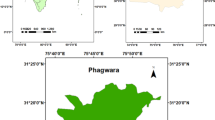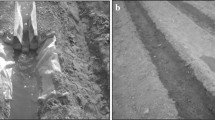Abstract
In this study, the volume balance equation and Elliott and Walker’s two-point method were employed to estimate the Kostiakov–Lewis (KL) infiltration equation parameters. The volume balance equation has a maximum point, whose location (distance) is a function of two parameters, r (constant parameter in advance equation) and fo. (final infiltration rate). If the length of the field is less than the distance of maximum point, then parameters of the infiltration equation obtained by the two-point method will have appropriate values. Otherwise, the values of infiltration parameters would depend on the values of r and fo, and there would be a possibility of their values being inappropriate. In this method, the soil texture of the field is assumed to be homogeneous; so, the relationship between r and fo is ignored, which may render the two-point method unsuitable in heterogeneous soils. By investigating the effect of soil heterogeneity on the values of r and fo, it was found that in the two-point method, point information is used for the estimation of parameters of the KL infiltration and that there is no clear relationship between these two points. As a result, a novel method was developed in this study to estimate the KL infiltration equation parameters and applied in three irrigation fields. The infiltration parameters obtained by the proposed method had appropriate values. The infiltration depth computed with the use of parameters so obtained was in close agreement with observed infiltration depth. Thus, the proposed method is potentially useful for estimating the KL infiltration equation parameters.







Similar content being viewed by others
Abbreviations
- \(a\) :
-
The exponent factor in the infiltration equation
- \(A\) :
-
Water flow cross-section at the beginning of the field
- \(f_{o}\) :
-
Final infiltration rate
- \(f_{1}\) :
-
Final infiltration rate at the beginning of the field
- \(i\) :
-
Cumulative infiltration
- \(I_{x}\) :
-
The average depth infiltrated along x from the beginning of the field by the exponential part of the infiltration equation
- \(i_{\text{Advance}}\) :
-
Average infiltration depth in the advance phase
- \(i_{\text{Total}}\) :
-
Average infiltration depth in the entire phase of irrigation time
- \(I_{L}\) and \(V_{L}\) :
-
The average depth infiltrated along L by the exponential part of the infiltration equation
- \(I_{{\frac{L}{2}}}\) and \(V_{{\frac{L}{2}}}\) :
-
Average depth infiltrated along L/2 by exponential part of the infiltration equation
- I max :
-
The maximum depth infiltrated through the exponential aspect of the Kostiakov–Lewis equation
- \(k\) :
-
Constant parameter in the infiltration equation
- \(L\) :
-
Field length
- \(p\) :
-
Constant parameter in advance equation
- \(Q_{o}\) :
-
Inflow rate to the field
- \(Q_{\text{out}}\) :
-
Outflow rate of the Field
- \(r\) :
-
Constant parameter in advance equation
- \(t\) :
-
Time of infiltration of water in soil
- \(t_{{\frac{{I_{L} }}{2}}}\) :
-
Time to advance to the point where it is \(I_{x} = \frac{{I_{L} }}{2}\)
- \(t_{L}\) :
-
The time for water advance to L
- \(t_{{\frac{L}{2}}}\) :
-
The time for water advance to L/2
- \(t_{x}\) :
-
The time for water advance to x
- \(x\) :
-
The length of the water advance in the field based on the beginning of the field
- \(\beta \left( {r,a + 1} \right)\) :
-
Beta function
- \(\varGamma\) :
-
Gamma function
- \(\lambda\) :
-
Ratio the first half permeability of the field to the permeability of the total e field
- \(\sigma_{y}\) :
-
The conversion parameter of the initial cross-sectional water flow to the average cross-sectional flow along the field
- \(\sigma^{\prime}_{z}\) and \(\sigma_{z}\) :
-
Subsurface shape factors
References
Benami A, Ofen A (1984) Irrigation engineering: sprinkler, trickle, surface irrigation; principles, design and agricultural practices. Irrigation Engineering Scientific Publication, IIIC Bet Dagan, Israel
Christiansen J, Bishop A, Kiefer F, Fok Y-S (1966) Evaluation of intake rate constants as related to advance of water in surface irrigation. Trans Asae 9:671–0674
Clemmens A (1983) Infiltration equations for border irrigation models
Elliott R, Walker W (1982) Field evaluation of furrow infiltration and advance functions. Trans Asae 25:396–0400
Fangmeier D, Ramsey M (1978) Intake characteristics of irrigation furrows. Trans Asae 21:696–0700
Grassi CJ (1972) Infiltration characteristics of furrow irrigation in a heavy-textured soil. Veenman
Green WH, Ampt G (1911) Studies on soil phyics. J Agric Sci 4:1–24
Holzapfel EA, Marin¯ o MA, Valenzuela A, Diaz F (1988) Comparison of infiltration measuring methods for surface irrigation. J Irrig Drain Eng 114:130–142
Horton RE (1939) Analysis of runoff-plat experiments with varying infiltration-capacity. EOS Trans Am Geophys Union 20:693–711
Karmeli D, Salazar L, Walker WR (1978) Assessing the spatial variability of irrigation water applications. Environ Protect Technol Series Epa (Usa). No. 600/2-78-041
Khaliq A, Iqbal M, Anwar S (1994) Evaluation of kostiakov infiltration equation parameters from irrigation advance in level basins. Pak J Agri Sa 31
Kiefer F Jr (1965) Average depth of absorbed water in surface irrigation. Special Publication. Civil Engineering Department, Utah State University, Logan
Kostiakov AN (1932) On the dynamics of the coefficient of water percolation in soils and the necessity of studying it from the dynamic point of view for the purposes of amelioration. Trans Sixth Comm Int Soc Soil Sci 1:7–21
Lewis M (1937) The rate of infiltration of water in irrigation-practice. Eos Trans Am Geophys Union 18:361–368
Ley TW (1978) Sensitivity of furrow irrigation performance to field and operation variables. Thesis Presented to Colorado State University, Fort Collins, CO, Partial Fulfillment of the Requirements for the Degree of M.Sc
Mohammadzadeh-Habili J, Heidarpour M (2015) Application of the green-ampt model for infiltration into layered soils. J Hydrol 527:824–832
Oyonarte N, Mateos L, Palomo M (2002) Infiltration variability in furrow irrigation. J Irrig Drain Eng 128:26–33
Philip J (1957a) The theory of infiltration: 1. The infiltration equation and its solution. Soil Sci 83:345–358
Philip JR (1957b) The theory of infiltration: 4. Sorptivity and algebraic infiltration equations. Soil Sci 84:257–264
Seyedzadeh A, Panahi A, Maroufpoor E, Singh VP (2019) Development of an analytical method for estimating manning’s coefficient of roughness for border irrigation. Irrig Sci 37:1–9
Shepard J, Wallender W, Hopmans J (1993) One-point method for estimating furrow infiltration. Trans Asae 36:395–404
Smith RE (1972) The infiltration envelope: results from a theoretical infiltrometer. J Hydrol 17:1–22
Valiantzas J, Aggelides S, Sassalou A (2001) Furrow infiltration estimation from time to a single advance point. Agric Water Manag 52:17–32
Walker WR (2005) Multilevel calibration of furrow infiltration and roughness. J Irrig Drain Eng 131:129–136
Walker WR, Skogerboe GV (1987) Surface Irrigation. Theory and practice. Prentice-Hall, Upper Saddle River
Walker W, Willardson L (1983) Infiltration measurements for simulating furrow irrigation
Zerihun D, Feyen J, Reddy JM (1996) Sensitivity analysis of furrow-irrigation performance parameters. J Irrig Drain Eng 122:49–57
Author information
Authors and Affiliations
Corresponding author
Ethics declarations
Conflict of interest
All authors declare they have no conflict of interest.
Additional information
Publisher's Note
Springer Nature remains neutral with regard to jurisdictional claims in published maps and institutional affiliations.
Rights and permissions
About this article
Cite this article
Seyedzadeh, A., Panahi, A., Maroufpoor, E. et al. Developing a novel method for estimating parameters of Kostiakov–Lewis infiltration equation. Irrig Sci 38, 189–198 (2020). https://doi.org/10.1007/s00271-019-00660-4
Received:
Accepted:
Published:
Issue Date:
DOI: https://doi.org/10.1007/s00271-019-00660-4




